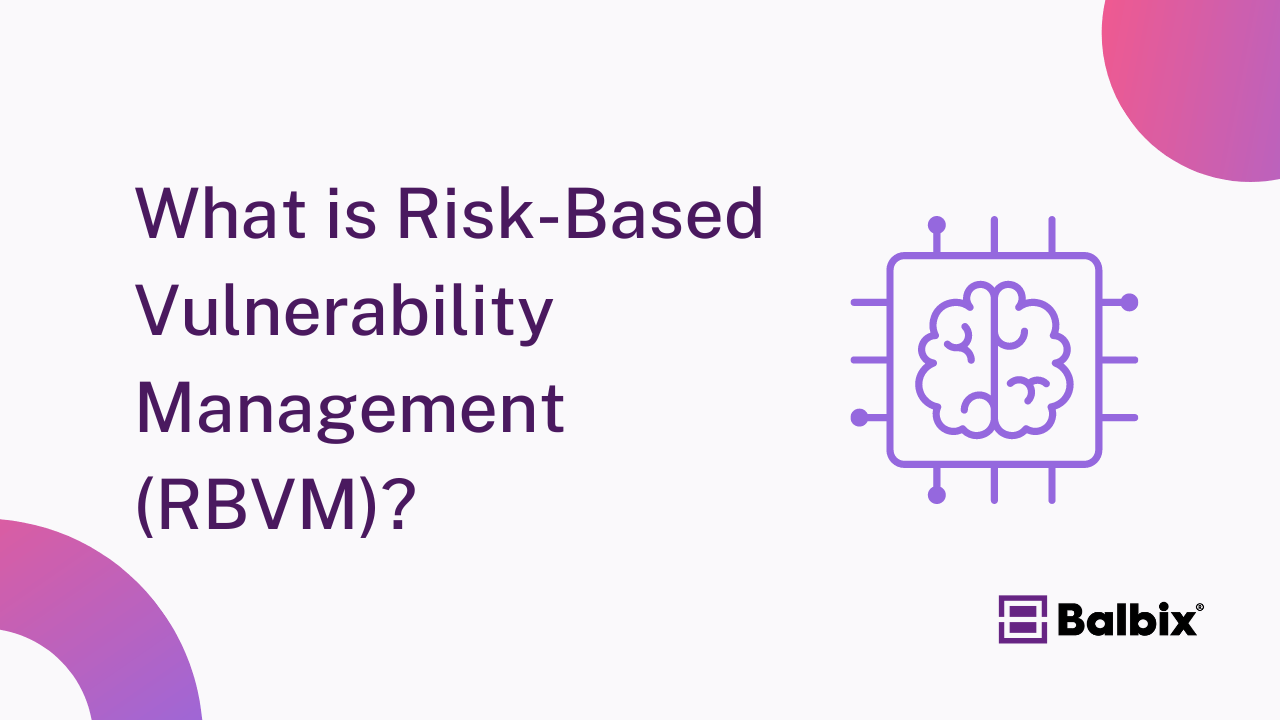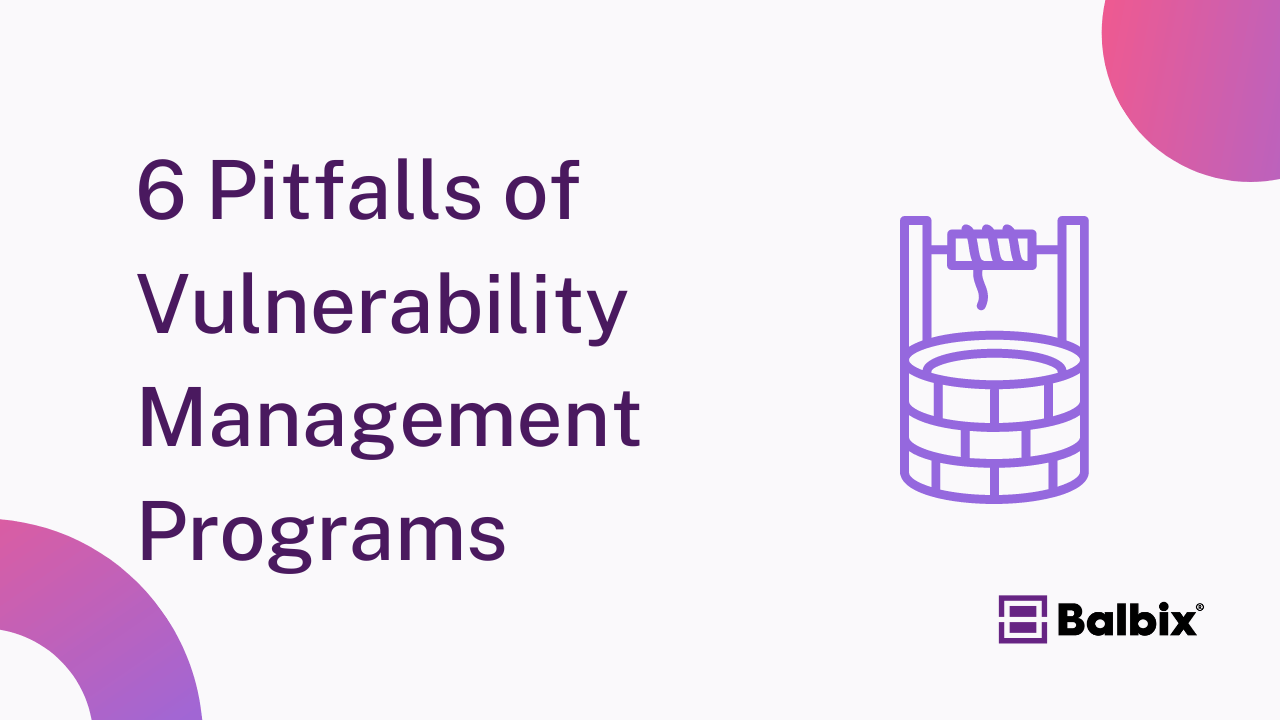Vulnerability management (VM) is an ongoing, proactive process designed to identify, assess, and remediate vulnerabilities within an organization’s IT environment. This critical practice helps reduce cyber risk and safeguard against potential cyberattacks.
VM is a continuous “health check” for your network and assets, helping organizations protect sensitive data, systems, and infrastructure from evolving cyber threats.
Keeping up with vulnerability management can be challenging, but staying ahead of these risks requires a clear, structured approach, which is why VM is essential to any cybersecurity strategy.
Risk-Based Vulnerability Management (RBVM)
Risk-Based Vulnerability Management (RBVM) is an approach that prioritizes vulnerabilities based on their potential impact on the organization. Rather than treating all vulnerabilities equally, RBVM uses business context, asset criticality, threat intelligence, and exposure to determine which vulnerabilities pose the greatest risk. This enables security teams to focus on mitigating the most critical issues, ensuring that resources are used effectively and reducing overall cyber risk in a more strategic, targeted manner.
Key Stages of Vulnerability Management
Effective vulnerability management follows a structured, multi-step approach that ensures thorough protection. Here are the four key stages:
1. Discovery
The first step in vulnerability management is identifying what to protect. You must have an up-to-date, comprehensive asset inventory. Scanning for vulnerabilities may miss critical areas without fully understanding your organization’s software, hardware, and data assets.
An automated asset discovery tool can help ensure comprehensive coverage. These tools, often enhanced with AI/ML, automate collecting, deduplicating, and analyzing asset data across your network. Automation helps identify all connected devices, software, and other assets, giving your security team a complete picture of potential vulnerabilities.
2. Prioritization
Not all vulnerabilities present the same level of risk, so prioritization is key. Effective VM programs employ a risk-based approach, considering factors such as:
- The value and sensitivity of the asset
- The severity of the vulnerability (e.g., CVSS score)
- Exposure level (is it internet-facing?)
- Threat intelligence (is the vulnerability actively exploited?)
- Existing mitigating controls
This ensures that your security team first addresses the most critical vulnerabilities, optimizing their time and resources. A sophisticated VM platform that integrates business context is crucial for making these risk-based decisions.
3. Response
Once vulnerabilities are identified and prioritized, organizations must choose how to respond. There are three primary strategies for handling vulnerabilities:
- Remediation: Fully fixing or patching the vulnerability.
- Mitigation: Reducing the risk of exploitation without fully resolving the issue.
- Risk Acceptance: Choosing not to take action and accepting the risk based on business priorities.
Utilizing a risk-based vulnerability management tool can guide you in selecting the most effective remediation strategy. These tools often offer scenarios that show how different actions will reduce risk, aligning remediation efforts with broader business goals.
4. Monitoring and Reporting
Continuous monitoring is essential to ensure the VM process remains effective. Regular scans should be scheduled to detect new vulnerabilities and track remediation efforts. Detailed reporting helps showcase progress, offering technical teams and executives valuable insights.
Monitoring key vulnerability metrics—such as mean time to remediation (MTTR), median age of open vulnerabilities (MOVA), and remediation success rate—helps keep stakeholders informed and supports a proactive security posture.
Benefits of Vulnerability Management
Vulnerability management offers several critical benefits to organizations, including:
- Reduced Risk of Cyber Attacks: Identifying and addressing vulnerabilities limits the attack surface, reducing the likelihood of successful cyberattacks.
- Regulatory Compliance: Many regulatory frameworks (e.g., GDPR, HIPAA) require organizations to manage vulnerabilities to maintain compliance.
- Operational Resilience: Effective VM reduces downtime by addressing issues before they disrupt business operations.
- Cost Savings: Proactive VM helps organizations avoid costly data breaches and associated legal fees.
- Improved Incident Response: Security teams can respond faster and more effectively during an incident by continuously monitoring vulnerabilities.
How to Choose the Right Vulnerability Management Tool
Choosing the right vulnerability management tool ensures your program’s success. Here are the factors to consider:
Conduct Regular Vulnerability Assessments
An effective VM tool should support regular vulnerability assessments to provide visibility into your organization’s security posture. These assessments should scan for known vulnerabilities and identify areas requiring attention.
Stop Sabotaging Your Cybersecurity
Avoid the 11 common vulnerability management pitfalls

Overcome Common VM Challenges
Modern IT environments are dynamic, and not all VM tools can handle this complexity. Look for tools that address common challenges such as:
- Limited visibility across unmanaged or cloud-based assets
- Reliance on outdated asset inventories
- Episodic rather than continuous scanning

Key Features to Look For
When selecting a VM tool, prioritize solutions that offer the following features:
- Automated asset discovery for complete visibility
- Risk-based vulnerability prioritization to focus on critical issues
- AI-powered analytics to enhance vulnerability detection and response
- Post-remediation scans to verify the success of patches or fixes
A comprehensive VM solution integrates these features to provide a clear, up-to-date picture of your security posture.
Best Practices for Vulnerability Management
To implement an effective vulnerability management program, follow these best practices:
- Inventory Your Assets: Regularly update your asset inventory to ensure you are protecting all systems, applications, devices, and data.
- Use AI/ML for Monitoring: Implement an AI-driven cyber risk management platform that monitors your assets and predicts which vulnerabilities will most likely be exploited.
- Prioritize Vulnerabilities: Use a risk-based approach to prioritize vulnerabilities based on their potential impact on your organization.
- Create a Patch Management Strategy: Ensure your team is prepared to address vulnerabilities by implementing an efficient patch management process.
Many organizations face pitfalls during implementation that prevent them from successfully running a vulnerability management program. Learn more about the common pitfalls and how to solve them here.
Conclusion
Vulnerability management is a critical element of cybersecurity. Organizations can significantly reduce their risk of cyberattacks by following the four-stage process of discovery, prioritization, response, and monitoring. Implementing a risk-based approach to VM ensures that security teams are focused on the most critical threats while maintaining operational resilience and regulatory compliance.
Explore our solutions to learn more about how Balbix can enhance your vulnerability management process and reduce cyber risk.
Frequently Asked Questions
- How does Risk-Based Vulnerability Management differ from traditional vulnerability management approaches?
-
Risk-Based Vulnerability Management focuses on prioritizing vulnerabilities based on the risk they pose to the organization. Unlike traditional approaches that might treat all vulnerabilities equally, this method evaluates factors like the severity of the vulnerability, the potential impact on the business, and the likelihood of exploitation. This way, organizations can allocate resources more effectively, addressing the most critical threats first to enhance their cybersecurity posture.
- How are vulnerabilities' CVSS scores determined, and why are they important for prioritization in a VM program?
-
Vulnerabilities’ CVSS scores are determined by evaluating the severity of their impact on affected systems, considering factors like how easily they can be exploited and the potential damage they can cause.
These scores are crucial for prioritization in a Vulnerability Management (VM) program because they help organizations identify which vulnerabilities pose the greatest risk to their systems. This allows them to address the most critical issues first and efficiently allocate their security resources.
- Can organizations handle the remediation process internally, or is it advisable to partner with external cybersecurity firms for effective vulnerability management?
-
Whether organizations can manage the remediation process on their own or need to work with outside cybersecurity companies depends on their own resources and expertise. If they have skilled IT staff, they might handle it internally.
However, partnering with external firms can offer more specialized skills and technologies for effective vulnerability management, especially for complex security issues.
- What are some common challenges organizations face when trying to maintain regulatory compliance through vulnerability management?
-
Organizations often struggle with keeping up with the vast number of regulations, which can change frequently. They also face difficulties in continuously identifying and patching vulnerabilities due to limited resources or expertise.
Another challenge is ensuring all parts of the organization are compliant, especially when they use a wide range of technologies. Moreover, the complexity of modern IT environments can make it hard to accurately assess risks and prioritize fixes.


